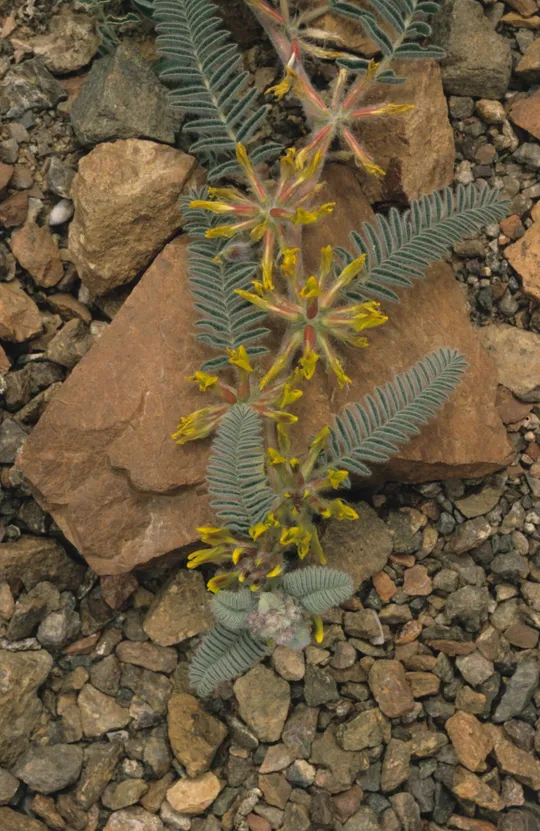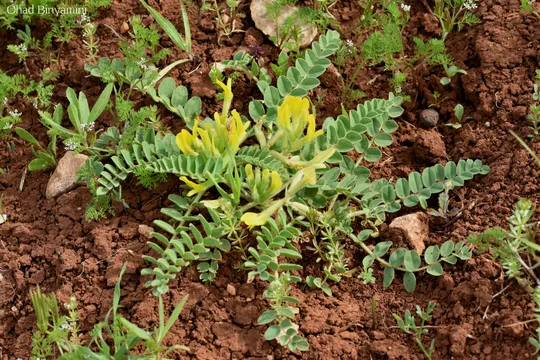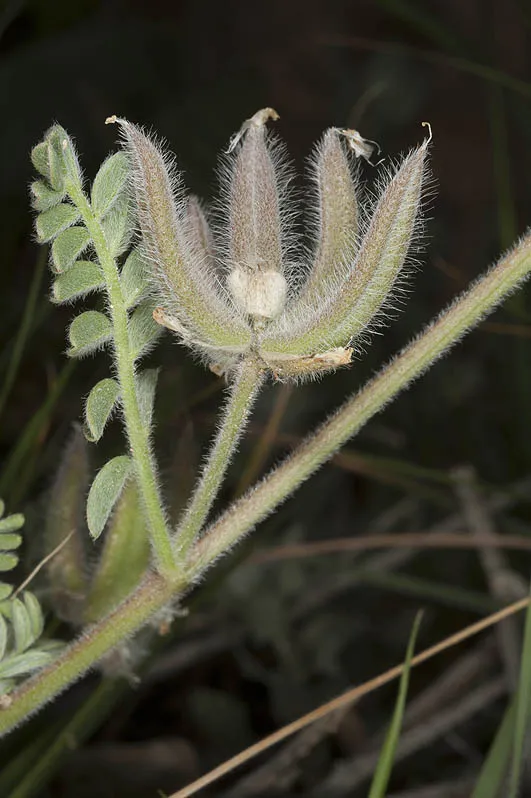Felt Milk-vetch
Astragalus fruticosus


Astragalus fruticosus grows on three sites in the northern Negev, where
it was found only a few times in the Ruhama
Badlands and in the Ashkelon
area , where it was last observed in 1970, but has not been found since. Mimi
Ron found A. fruticosus in 2003 near Netiv HaAsara north
of Wadi Shikma. It was collected for the
first time and identified in Israel in 1924 in the Rafiah area. There are additional
reports from the Gaza region, from Netsarim and Gan Or, in 1989-1991 (Michael
Even-Esh). Other observations from Nitsanim (Pleshet), Memshit (Northern Negev)
and Mount Karkom (Southern Negev) are dubious.
Globally – arid sandy deserts (below 70 mm precipitation),
particularly in valleys, where sand mixed with loess accumulates. In Israel, on
the northern edge of its distribution area, it is found in rainier areas: in
the Ruhama Badlands on compacted loess crusts on wadi margins and in Netiv
HaAsara on sand.
For
the characteristics of the genus Astragalus – see A. trimestris. For the global and local distribution
of Astragalus – see A. oocephalus.
According to Zohary (1972), A. fruticosus belongs
to the section Coronopus, which includes perennial species that have a central,
almost unbranched stem and long pinnate leaves arranged in a spiral around the
stem; in most species of the section the petioles of the previous season harden
and become thorny and possibly protect the plant. At the base of the leaf,
there are clumps of large yellow, nectar-rich flowers. The fruit is a pod with
a sharp hardened beak, which dehisces (opens) at the top when ripe.
The species close to A. fruticosus
– A. dactylocarpus, A. sieberi, and A. trigonus, are all
thorny, but A. fruticosus is not – its leaf petioles do not harden and form
rigid thorns. According to literature, A. fruticosus
is not thorny, although individuals with old thorny petioles are known from the
field. It is possible that A. fruticosus is not an
independent taxon and that it should be considered a subunit of A. dactylocarpus (because of its
pod that has a pointed and spiny beak). Nevertheless,
all the Middle East floras treat it as an independent species. Another close
species is A. sparsus,
which has only 10-15 pairs of narrower elongated leaflets; it is prostrate, whereas
A. fruticosus is erect. Its calyx teeth are short and reach up to
between a third and half the length of the calyx, while in A. fruticosus
the length of the teeth are the same as the length of the calyx tube. The A.
sparsus pod is shorter and narrower than that of A. fruticosus: it
is 3-4.5 cm long and 7-8 mm wide. The habitat of A. sparsus is hot wadi channels
in the mountains of the Arabian-Nubian Massif whereas A. fruticosus
grows in extreme sand and limestone deserts.
·
Astragalus
fruticosus grows in only one region – Pleshet, and even there it
was found only a few times. It may be extinct from the Ruhama Badlands. There
is currently insufficient information on the change trends in the number of
sites, but there seems to be a decline in their numbers. It may possibly
survive within the Gaza Strip.
·
A. fruticosus
grows mostly as sparsely scattered plants, occasionally only a single
individual at a site.
·
The site at the
Ruhama Badlands is located in a declared nature reserve.
·
It is not found
in the red species lists of the neighboring countries and there is no
information available on its global threat and conservation status.
The sites at which Astragalus
fruticosus was collected or observed should be thoroughly surveyed
and efforts made to locate other sites in sandy habitats and in their
derivatives in southern Pleshet and the western Negev. The resulting data will allow
assessments to be made, from which conservation and management processes can be
formulated.
Astragalus fruticosus is endemic to
the sands of Egypt, Sinai and the western Negev in Israel. According to the
Flora Palaestina it also grows in southern Jordan, but there are no herbarium
sheets from the region.
Astragalus fruticosus is an extremely
rare perennial grass with a few individuals found in southern Pleshet and the Gaza
area. Updated information is needed to assess its status in Israel.
Podlech D. 2005, Thesaurus Astragalorum, 2: all taxa described within and belonging to the genus Astragalus L.; Taxa of the Old World and related taxa of the New World. Compiled by D. Podlech (Mnchen) with assistence of Sh. Zarre (Tehran) Mnchen,
Eig, A. 1955, Systematic studies on Astragali of the Near East. Israel Science Press Jerusalem
Current Occupancy Map
| 1000 squre meter pixel | 5000 squre meter pixel | 10000 squre meter pixel | |
|---|---|---|---|
| number of observations | 0 | 0 | 0 |
| in total pixels | 0 | 0 | 0 |
| Family | Fabaceae |
| Classification | On the endangered species list |
| Ecosystem | Desert |
| Chorotype | Saharo - Arab |
| Conservation Site | On the Ruhama badlands |
| Rarity |
1
5
6
|
|---|---|
| Vulnerability |
0
3
4
|
| Attractiveness |
0
0
4
|
| Endemism |
0
0
4
|
| Red number |
1
4.7
10
|
| Peripherality | S |
| IUCN category | DD EW EX LC CR EN VU NT |
| Threat Definition according to the red book | Endangered |
 Based on:
Based on:






